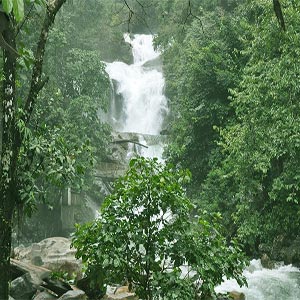The highest climber- friendly mountain in South East Asia, Mount Kinabalu is situated in East Malaysia, in the state of Sabah on the island of Borneo, popularly called 'the land below the wind.' This is the place to witness a breathtaking sunrise from above the clouds and above the sea level.
The first thing that strikes about Mount Kinabalu is that it is extremely climber friendly even when compared to other lower mountains of the world – ideal first mountain for novice mountain climbers to conquer.
Mount Kinabalu towers about 4095 meters above sea level and is the highest mountain between the mighty snow-capped Himalayas in India and Wilhelmina in Irian Java.
A mountain of tropical rainforest, Mount Kinabalu is laden with colorful blossoms and golden sunset amidst dark and violent storms. No wonder then that legendary local Kadazandusun's claim that it is the homeland of their spirit world.
Trail of Kinabalu
Thousands of tourists flock to Kinabalu National Park every year with the intention of climbing the Mount. It just takes about two days to ascend and descend Kinabalu and there is no need for any previous experience in mountain climbing. At sunrise, the views of Mt Kinabalu are simply awesome, making the climb truly memorable and worthwhile.
For most climbers, the eight kilometer climb of the mount starts with the Timpohon Gate near park headquarters with an overnight stay at one of the guest houses at Laban Rata before embarking to the summit early next morning.
After ascending the mountain in time to view the sunrise, they return to Laban Rata for breakfast. A savvy climber can feel the difference as the track elevation approaches 3000 m where the alpine terrain and floral growth is now markedly different from the rainforest below.
There is little chance for injury for climbers of Kinabalu. Although there have been incidents when climbers have been lost, injured and killed on the mountain, this is mainly due to poor weather conditions and more often when they leave the marked track. If the climber listens to the guide's instructions, there is no need to fear to climb.
However, climbers could experience mild headache, some nausea and vomiting. If the climber suffers badly from altitude sickness, then the remedy would be to return to a lower altitude immediately. The trail of Mount Kinabalu winds along the southern side of the mountain. It is an 8.5 km trek to the top.
There are rest huts at roughly 1km break in the trail. A climber needs to carry enormous amounts of water and refill them at tanks on the way. Food and torch are must-haves during the climb.
Most often than not, the effects of the climb can be felt during the descent when one can take a glimpse into the dizzy gash of low gully which splits the eastern side of the mountain. The Kinabalu headquarters is located some 90 kms from Kota Kinabalu Sabah's capital city. More than one million visitors enjoy the park since its opening in the year 2000.
Kinabalu National Park
Although Kinabalu is renowned for flora and fauna, the Timpohon track boasts little wildlife. The best that one can see is an earthworm – 40 m long. As for the flora, plenty of wild flowers and few orchids abound the track.
About 90 km from Kota Kinabalu, the National Park is one of the world's most significant natural environments. The park houses thousands of flora and fauna that are native to this locale.
Kinabalu National Park has been declared a UNESCO World Heritage Site in 2000 in Malaysia. The presence of Mount Kinabalu is one of the important contributing factors for a wide variety of animals, bird, and insect and plant life to be found in the park.
The terrain ranges from lush green rainforest at the park's lower altitudes to rhododendron and coniferous forests. Small marsupials survive in a harsh environ in this park.
The most famous pitcher plant endemic to Kinabalu National Park is Nepenthes raja, a giant pitcher plant whose bell can hold more than three liters of water. World's largest flower, Rafflesia, weighing 10 kgs, which blooms exceptionally, has also found its home in this park. Botanists around the world keenly await the blossoming of this flower. Rafflesia emits a foul smell, reminiscent of rotting. The stench attracts flies and insects which the plant then feasts upon.
Reaching Mount Kinabalu
The standard route to get to Kota Kinabalu is via Kuala Lumpur. The climate is tropical in Borneo with an average daily temperature around 32 degree C. In mountains it is normally hotter during the day and cooler at nights. The temperature at Kinabalu can drop to 15 degree C.
In Sabah, the main rainy season ranges from November to January and mornings are usually clear at any season. Sabah also lies below typhoon belt. Rainfall is high and often torrential.
The best time to visit Mount Kinabalu is during the dry season from February to April when walking and climbing is much more enjoyable. And the weather can change very quickly from brilliant sunshine, mist and clouds to a torrential downpour.
Travel to Mount Kinabalu
- Rucksack with water proof plastic liner
- Water proof jackets
- T shirts and long sleeve shirt
- Comfortable socks – several pairs
- Warm sweater / jacket
- Tracksuit bottom/light trousers
- Neck scarf
- Strong training shoes and high grip tread pattern
- Torch and spare batteries, spare bulb
- Water bottles
- Toiletries including medication
Anyone with a reasonable level of fitness and will power can climb the summit of Kinabalu. The achievement should be incredibly rewarding indeed!

